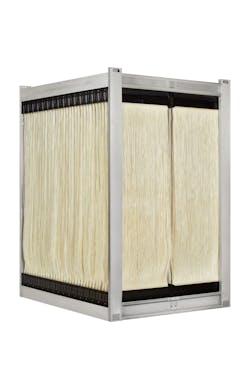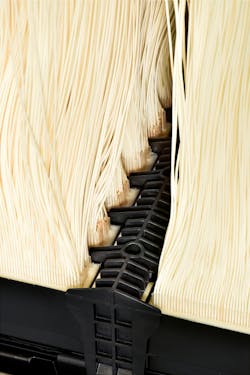Membrane bioreactor systems can target current, future wastewater challenges
Water stress is a persistent global risk that threatens communities everywhere.
Today, some 2.3 billion people worldwide live in water-stressed countries and around 1.4 billion live in areas of high or extremely high water vulnerability, according to UN-Water and UNICEF. In recent decades, the challenges of water have become increasingly complex as population growth places higher demand on limited water resources and a changing climate makes water availability more unpredictable.
According to the World Economic Forum, water is becoming scarcer as regional sources deplete or disappear while greater variability in rainfall—with prolonged periods of drought punctuated by more intense storms and flooding—makes water resources harder to manage.
In view of these concerns, water utilities need solutions that provide resilience to the extremes, whether water is scarce or there is too much of it. One of the most effective ways for establishing a reliable and locally controlled supply is through water recycling and reuse.
Wastewater reuse
As a diversification strategy, treating wastewater for beneficial reuse helps alleviate water shortage risks while reducing the strain on freshwater sources. It also takes a more holistic approach to water management and recognizes wastewater as a resource that holds inherent value.
More communities are incorporating water reuse into their water management portfolios. A recent survey from Bluefield Research concluded that the volume of recycled water produced in the U.S. is projected to increase 37% from 4.8 billion to 6.6 billion gallons per day by 2027.
At the same time, the water sector faces evolving regulatory challenges, especially with regard to contaminants of emerging concern including PFAS, pharmaceuticals and personal care products, medicines, pesticides, and more. Many municipalities are also dealing with aging infrastructure and undersized wastewater treatment systems and need to upgrade or expand capacity to meet current and future demands. Capital improvements that increase treatment capabilities are also needed to build climate resiliency—an adaptive approach to both drought and more intense wet weather events that generate abnormally high flows.
To address this combination of challenges and needs, more water utilities are selecting membrane bioreactor systems (MBRs) for their ability to produce a higher quality effluent and to fit in a smaller footprint.
About ZeeWeed
One treatment technology for large municipal conventional upgrades and greenfield MBRs is Veolia's ZeeWeed 500 hollow-fiber ultrafiltration membranes.
The ZeeWeed 500 series of immersed membranes are designed for greater solid tolerances to treat high turbidity water, including difficult-to-treat water sources and wastewaters. By combining a physical solids separation barrier with advanced biological treatment, a ZeeWeed MBR approach can help communities meet non-potable recycling requirements.
If the need arises to move to indirect potable reuse, like freshwater augmentation or direct potable reuse, a ZeeWeed MBR plant can be a key component. And, by boosting treatment capacity in a reduced footprint, the ZeeWeed 500 MBR presents a solution for municipalities facing upgrade needs but lacking the space to expand.
A legacy of MBR performance
Last year was the 25th anniversary of the ZeeWeed 500 family of products and the 30th anniversary of the first ZeeWeed MBR.
The 500 series was introduced in 1997 with the launch of the ZeeWeed 500A. Over the years that followed, it earned a reputation for its membrane reliability and product life. Some municipal customers using the ZeeWeed 500 series have achieved 12 to 16 years of operation, and some have realized even longer.
Today, over 2500 MBRs with more than 1.4 million ZeeWeed 500 membranes are installed and operating globally.
One of them is at a wastewater treatment plant (WWTP) owned and operated by the Hallsdale Powell Utility District (HPUD) in Knoxville, Tennessee. According to HPUD Treatment and Operations Manager Nick Jackson, the Utility District was facing numerous requirements and the ZeeWeed 500 offered a multifaceted solution.
“We had an aging and undersized plant on a 303 [d] stream and were under a state consent decree to make some changes,” Jackson said. “We wanted to choose a process that would not only meet today’s regulations but would give us future proofing for those in the years to come. The ZeeWeed MBR checked all those boxes.”
While Jackson said they don’t foresee any limit changes on the near-term horizon, they do believe that tighter nutrient limits and emerging contaminants — including synthetics, hormones, and microplastics — are issues the water sector will face in the foreseeable future.
“As the regulatory environment changes, the ZeeWeed membrane puts us in a position to deal with all of those concerns — it’s one of the reasons we selected it as our technology,” he said. “And I’m happy to report that, over a decade of operations, the ZeeWeed technology has performed flawlessly.”
Evolution of the ZeeWeed 500 portfolio
Recently, the ZeeWeed 500 series expanded with the introduction of the ZeeWeed 500EV.
Compared to older generation ZeeWeed 500 products, the new configuration reduces the membrane tank footprint by up to 50% while lowering energy costs by 20%. Additionally, with over 60% fewer parts, the evolved product simplifies maintenance.
The new ZeeWeed 500EV configuration has already been installed in wastewater treatment expansions across North America. One includes the City of Pooler in Georgia, which approved a $49 million project that involves building a new facility adjacent to an existing WWTP that has employed ZeeWeed 500D MBR technology for nearly two decades.
According to the city, the ZeeWeed 500D MBR has produced high quality effluent at their exiting treatment plant for over 18 years, and it is that proven performance that led them to include the evolved ZeeWeed 500EV in their new facility.
Another example is a municipality in Saskatchewan, Canada, which needed to expand and upgrade its existing wastewater treatment plant. The municipality wanted to implement a technology that would provide both a higher effluent quality and options for alternative discharge locations, including possible water reuse.
The municipality reviewed and evaluated multiple technologies, and determined that MBR was the best fit due to its demonstrated track record and ability to meet future water quality limits. Over the course of the design process, the project team explored options that would save on capital or operating costs. The ZeeWeed 500EV offered both. By selecting the ZeeWeed 500EV, the membrane system upgrade required fewer cassettes, resulting in lower installation and operating costs as well as a 25% reduction in the carbon footprint for shipping and transportation.
Plant decisions for future goals
When municipalities are making decisions about wastewater plant investments, they need to consider both current and future wastewater treatment goals, since the decisions made today will likely have an impact for the next 20 to 30 years.
The ZeeWeed 500 MBR offers a versatile solution and the benefit of a phased implementation. Depending on the flowsheet configuration, individual treatment lines can be converted to full MBR over time — as was done for the Henriksdal WWTP in Stockholm, Sweden.
lternatively, a parallel membrane train can be built that makes use of the same bioreactor as the conventional system, running in a hybrid MBR mode. An example is the Soreq (Jerusalem West) WWTP in Israel that is currently under construction.
The benefit of the hybrid approach is that the biological portion of the conventional plant remains unchanged. This is a useful solution for municipalities that want to treat a portion of their flow for reuse or to meet new regulatory requirements but have newer clarifiers and don't want to replace them prematurely.
Whether municipalities are trying to address wastewater challenges or implement a water reuse scheme, technologies such as MBR can be the answer to save energy and deliver excellent performance and membrane life.
About the Author
Jennifer Lim
Jennifer Lim is the product line director for Veolia Water Technologies & Solutions's ZeeWeed 500 Membrane and MBR.


